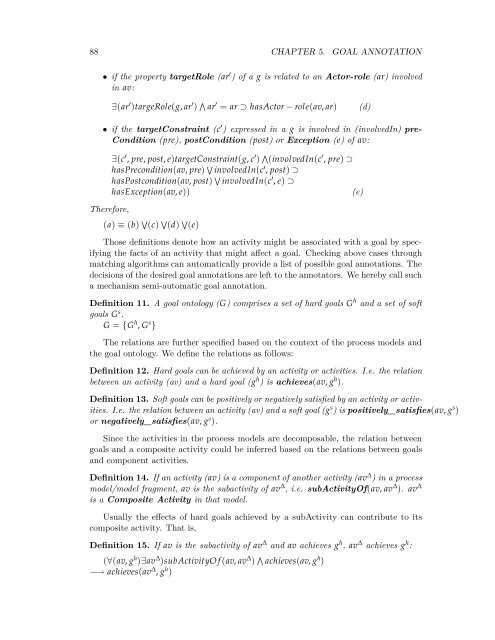Semantic Annotation for Process Models: - Department of Computer ...
Semantic Annotation for Process Models: - Department of Computer ...
Semantic Annotation for Process Models: - Department of Computer ...
Create successful ePaper yourself
Turn your PDF publications into a flip-book with our unique Google optimized e-Paper software.
88 CHAPTER 5. GOAL ANNOTATION<br />
• if the property targetRole (ar ′ ) <strong>of</strong> a g is related to an Actor-role (ar) involved<br />
in av:<br />
∃(ar ′ )targeRole(g, ar ′ ) ∧ ar ′ = ar ⊃ hasActor − role(av, ar)<br />
(d)<br />
• if the targetConstraint (c ′ ) expressed in a g is involved in (involvedIn) pre-<br />
Condition (pre), postCondition (post) or Exception (e) <strong>of</strong> av:<br />
∃(c ′ , pre, post, e)targetConstraint(g, c ′ ) ∧ (involvedIn(c ′ , pre) ⊃<br />
hasPrecondition(av, pre) ∨ involvedIn(c ′ , post) ⊃<br />
hasPostcondition(av, post) ∨ involvedIn(c ′ , e) ⊃<br />
hasException(av, e))<br />
(e)<br />
There<strong>for</strong>e,<br />
(a) ≡ (b) ∨ (c) ∨ (d) ∨ (e)<br />
Those definitions denote how an activity might be associated with a goal by specifying<br />
the facts <strong>of</strong> an activity that might affect a goal. Checking above cases through<br />
matching algorithms can automatically provide a list <strong>of</strong> possible goal annotations. The<br />
decisions <strong>of</strong> the desired goal annotations are left to the annotators. We hereby call such<br />
a mechanism semi-automatic goal annotation.<br />
Definition 11. A goal ontology (G) comprises a set <strong>of</strong> hard goals G h and a set <strong>of</strong> s<strong>of</strong>t<br />
goals G s .<br />
G = {G h , G s }<br />
The relations are further specified based on the context <strong>of</strong> the process models and<br />
the goal ontology. We define the relations as follows:<br />
Definition 12. Hard goals can be achieved by an activity or activities. I.e. the relation<br />
between an activity (av) and a hard goal (g h ) is achieves(av, g h ).<br />
Definition 13. S<strong>of</strong>t goals can be positively or negatively satisfied by an activity or activities.<br />
I.e. the relation between an activity (av) and a s<strong>of</strong>t goal (g s ) is positively_satisfies(av, g s )<br />
or negatively_satisfies(av, g s ).<br />
Since the activities in the process models are decomposable, the relation between<br />
goals and a composite activity could be inferred based on the relations between goals<br />
and component activities.<br />
Definition 14. If an activity (av) is a component <strong>of</strong> another activity (av ∆ ) in a process<br />
model/model fragment, av is the subactivity <strong>of</strong> av ∆ , i.e. subActivityOf(av, av ∆ ). av ∆<br />
is a Composite Activity in that model.<br />
Usually the effects <strong>of</strong> hard goals achieved by a subActivity can contribute to its<br />
composite activity. That is,<br />
Definition 15. If av is the subactivity <strong>of</strong> av ∆ and av achieves g h , av ∆ achieves g h :<br />
(∀(av, g h )∃av ∆ )subActivityO f(av, av ∆ ) ∧ achieves(av, g h )<br />
−→ achieves(av ∆ , g h )
















